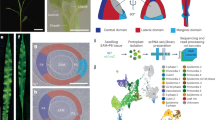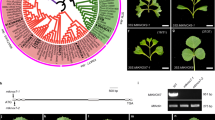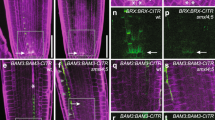Abstract
THE Knotted-1 (Kn1) locus is defined by several dominant gain-of-function mutations that alter leaf development. Foci of cells along the lateral veins do not differentiate properly, but continue to divide, forming outpocketings or knots. The ligule, a fringe normally found at the junction of leaf blade and sheath, is often displaced and perpendicular to its normal position1–3. The phenotype is manifested in all cell layers of the leaf blade, but is controlled by a subgroup of cells of the inner layer4. Mutations result from the insertion of transposable elements5 or a tandem duplication6. We show that the Kn1 gene encodes a homeodomain-containing protein, the first identified in the plant kingdom. Sequence comparisons strongly suggest that Kn1 acts as a transcription factor. Here we use the Kn1 homeobox to isolate other expressed homeobox genes in maize. The Kn1 homeobox may permit the isolation of genes that, like animal and fungal counter-parts7, regulate cell fate determination.
This is a preview of subscription content, access via your institution
Access options
Subscribe to this journal
Receive 51 print issues and online access
$199.00 per year
only $3.90 per issue
Buy this article
- Purchase on Springer Link
- Instant access to full article PDF
Prices may be subject to local taxes which are calculated during checkout
Similar content being viewed by others
References
Bryan, A. A. & Sass, J. E. J. Hered. 32, 343–346 (1941).
Gelinas, D., Postlethwait, S. N. & Nelson, O. E. Am. J. Bot. 56, 671–678 (1969).
Freeling, M. & Hake, S. Genetics 111, 617–634 (1985).
Sinha, N. & Hake, S. Devl Biol. 141, 203–210 (1990).
Hake, S., Vollbrecht, E. & Freeling, M. EMBO J. 8, 15–22 (1989).
Veit, B., Vollbrecht, E., Mathern, J. & Hake, S. Genetics 125, 623–631 (1990).
Gehring, W. J. Science 236, 1245–1252 (1987).
Lipman, D. J. & Pearson, W. R. Science 227, 1435–1441 (1985).
Scott, M. P., Tamkun, J. W. & Hartzell III, G. W. Biochim. biophys. Acta 989, 25–48 (1989).
Qian, Y. Q. et al. Cell 59, 573–580 (1989).
Kissinger, C. R. et al. Cell 63, 579–590 (1990).
Nourse, J. et al. Cell 60, 535–545 (1990).
Kamps, M. P. et al. Cell 60, 547–555 (1990).
Kelly, M. et al. EMBO J. 7, 1537–1547 (1988).
Garnier, J., Osguthorpe, D. J. & Robson, B. J. molec. Biol. 120, 97–120 (1978).
Poole, S. J. et al. Cell 40, 37–43 (1985).
Coleman, K. G. et al. Genes Dev. 1, 19–28 (1987).
Bürglin, T. R. et al. Nature 341, 239–243 (1989).
Mlodzik, M., Anders, F. & Gehring, W. J. EMBO J. 7, 2569–2578 (1988).
Mlodzik, M. & Gehring, W. J. Cell 48, 465–478 (1987).
LaRosa, G. J. & Gudas, L. J. Molec. cell. Biol. 8, 3906–3917 (1988).
Wharton, K. A. et al. Cell 40, 55–62 (1985).
Rogers, S., Wells, R. & Rechsteiner, M. Science 234, 364–368 (1986).
Eisenberg, D., Weiss, R. M. & Terwilliger, T. C. Nature 299, 371–374 (1982).
Ptashne, M. Nature 335, 683–689 (1988).
Murre, C., McCaw, P. S. & Baltimore, D. Cell 56, 777–783 (1989).
Langdale, J. A., Lane, B., Freeling, M. & Nelson, T. Devl Biol. 133, 128–139 (1989).
Hake, S., Bird, R. M., Neuffer, M. G. & Freeling, M. in Plant Genetics (ed. Freeling, M.) 61–71 (Us New York, 1985).
Harding, K. et al. Science 233, 953–959 (1986).
Fjose, A., McGinnis, W. J. & Gehring, W. J. Nature 313, 284–289 (1985).
Dalton, D., Chadwick, R. & McGinnis, W. Genes Dev. 3, 1940–1956 (1989).
Hanley, B. A. & Schuler, M. A. Nucleic Acids Res. 16, 7159–7176 (1988).
Sambrook, J., Fritsch, E. F. & Maniatis, T. Molecular Cloning: A Laboratory Manual (Cold Sprin Harbor Laboratory Press, Cold Spring Harbor, NY, 1989).
McGinnis, W. et al. Nature 308, 428–433 (1984).
Author information
Authors and Affiliations
Rights and permissions
About this article
Cite this article
Vollbrecht, E., Veit, B., Sinha, N. et al. The developmental gene Knotted-1 is a member of a maize homeobox gene family. Nature 350, 241–243 (1991). https://doi.org/10.1038/350241a0
Received:
Accepted:
Issue Date:
DOI: https://doi.org/10.1038/350241a0
This article is cited by
-
Characterization and expression profiles of WUSCHEL-related homeobox (WOX) gene family in cultivated alfalfa (Medicago sativa L.)
BMC Plant Biology (2023)
-
A potential candidate gene associated with the angles of the ear leaf and the second leaf above the ear leaf in maize
BMC Plant Biology (2023)
-
Evolutionary Consequences of Functional and Regulatory Divergence of HD-Zip I Transcription Factors as a Source of Diversity in Protein Interaction Networks in Plants
Journal of Molecular Evolution (2023)
-
Morphological and Transcriptional Analyses of Regeneration Events in Pepper Plants (Capsicum annuum) Expose Patterns of Shoot Apical Meristem Formation
Journal of Plant Growth Regulation (2023)
-
Genome-wide analysis of TALE superfamily in Triticum aestivum reveals TaKNOX11-A is involved in abiotic stress response
BMC Genomics (2022)
Comments
By submitting a comment you agree to abide by our Terms and Community Guidelines. If you find something abusive or that does not comply with our terms or guidelines please flag it as inappropriate.



